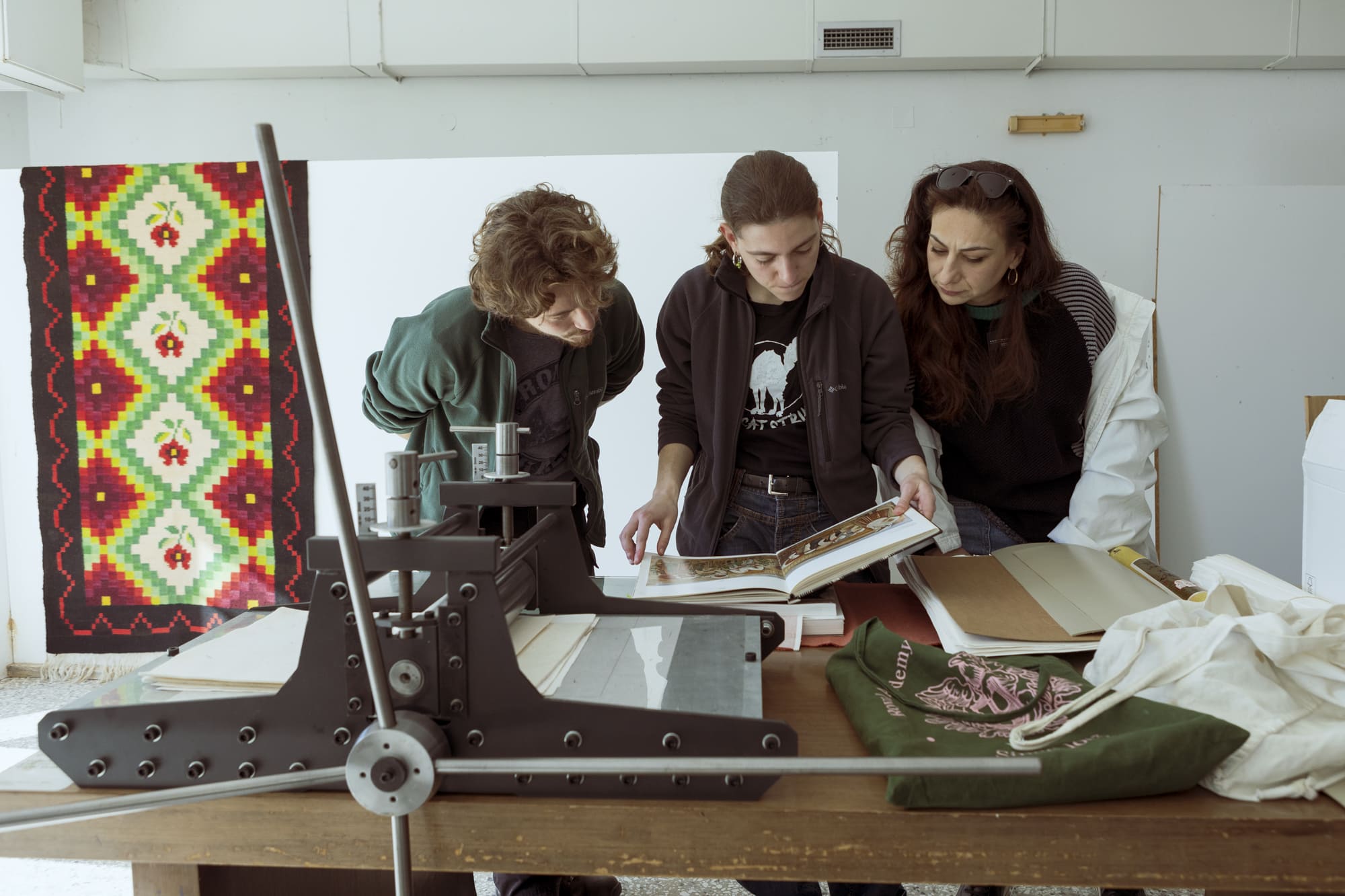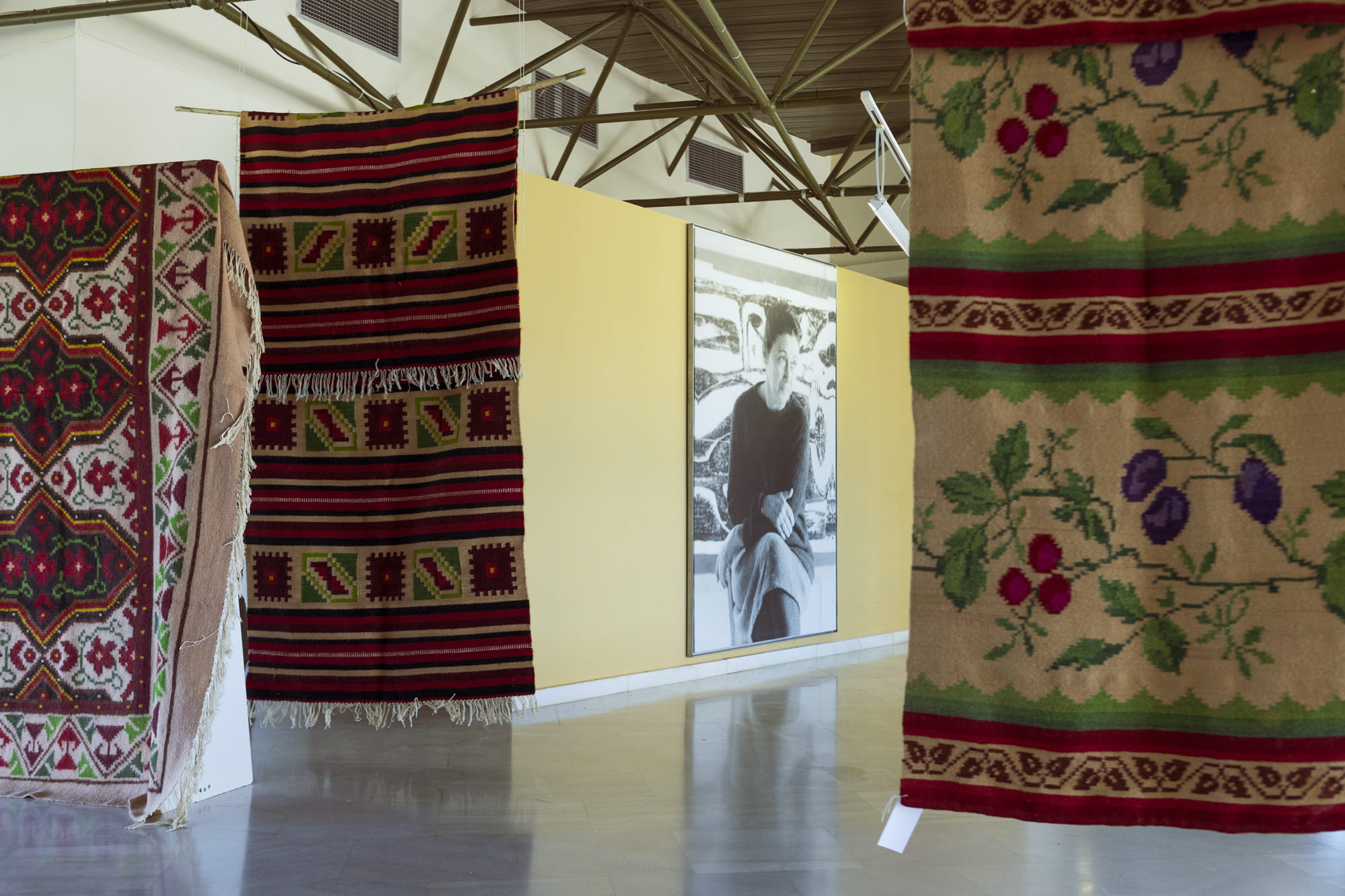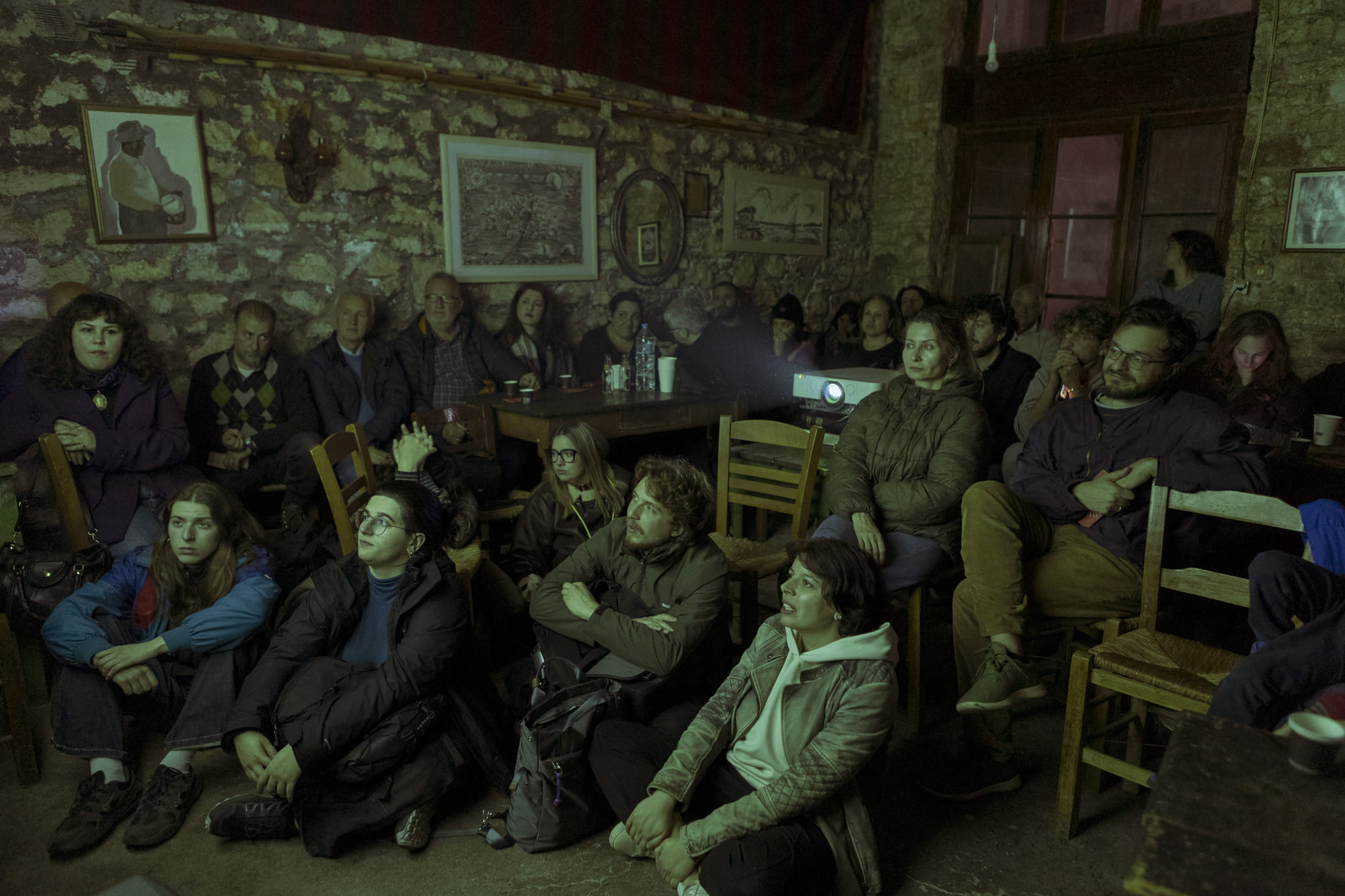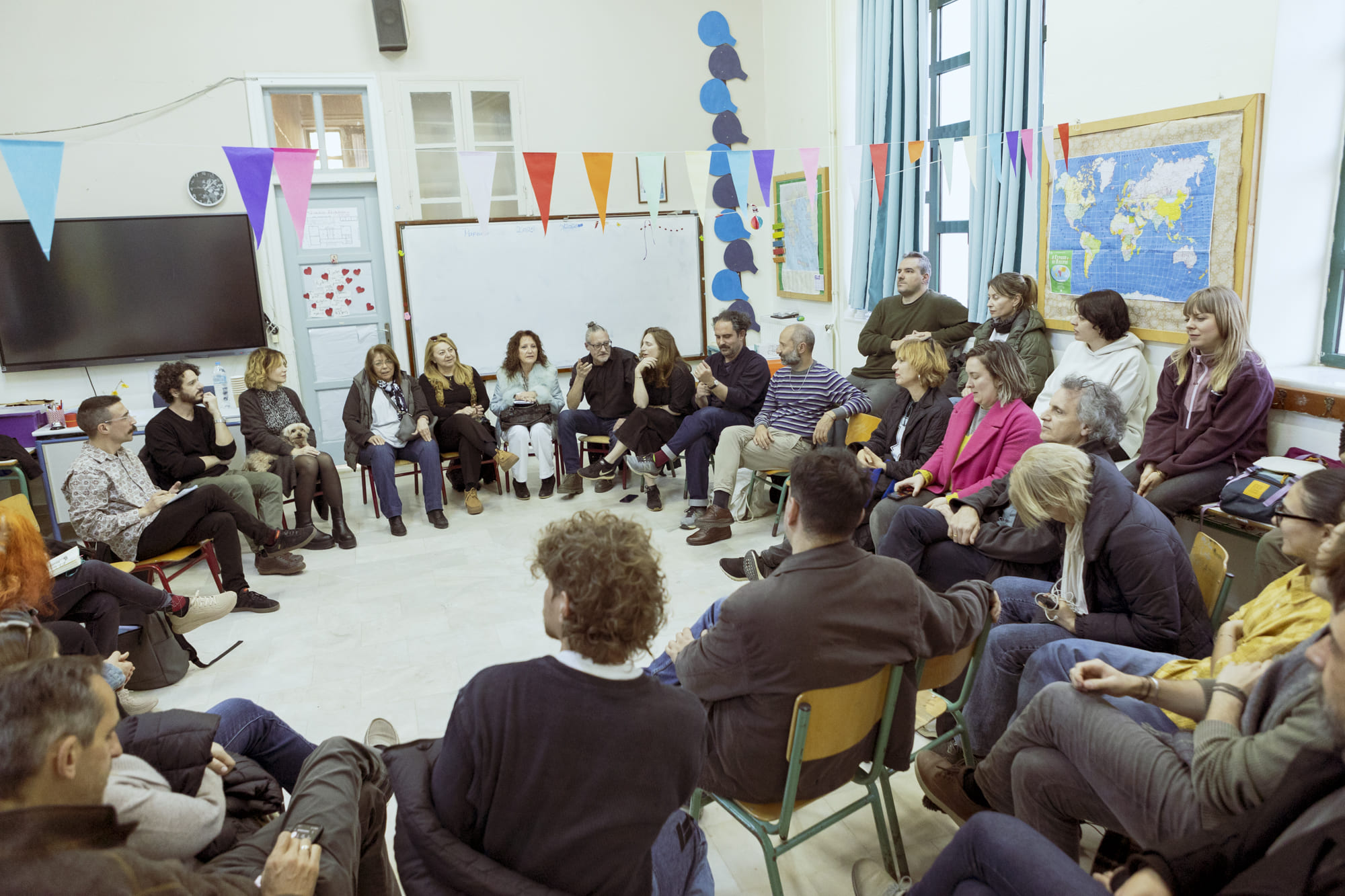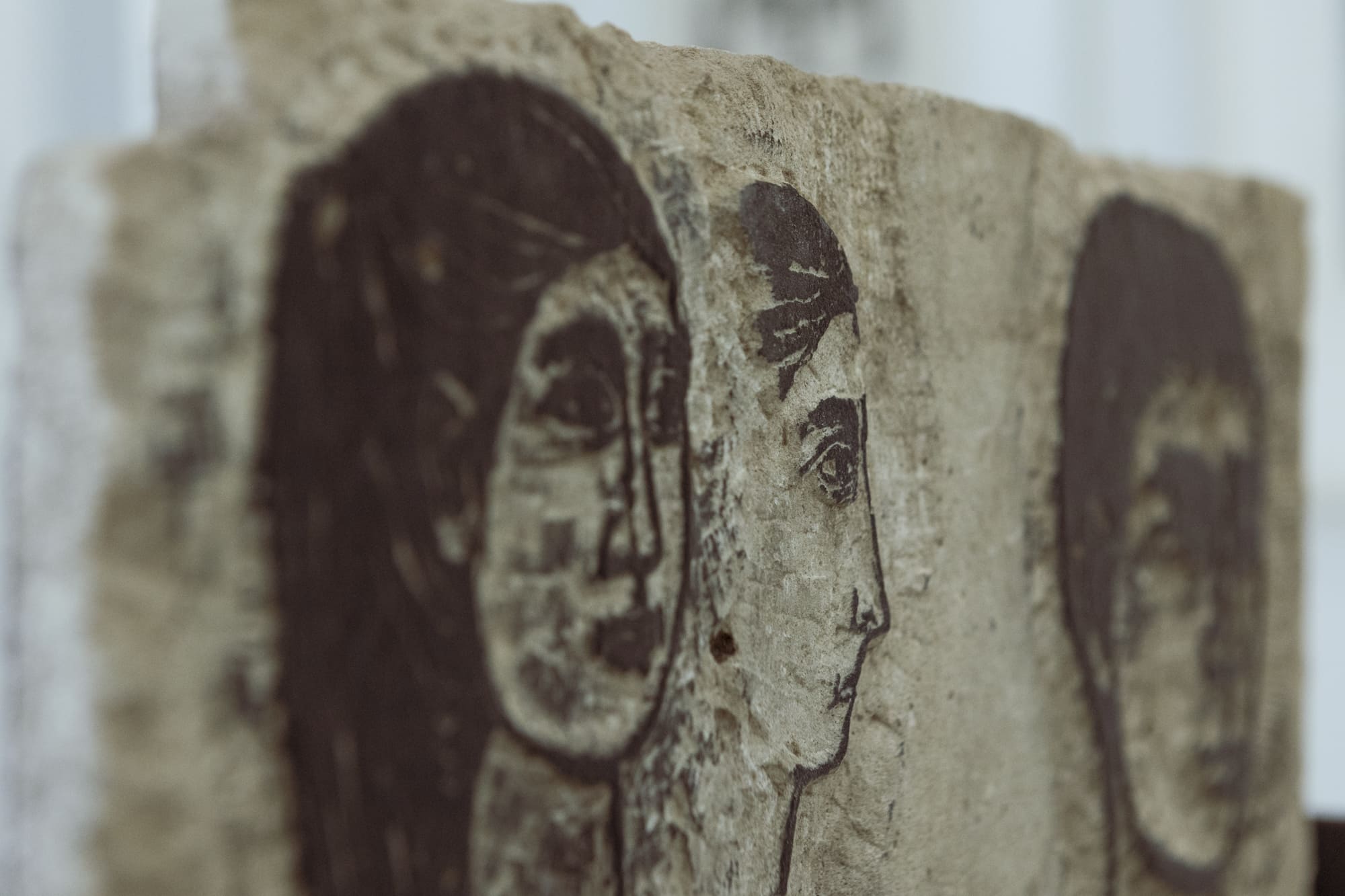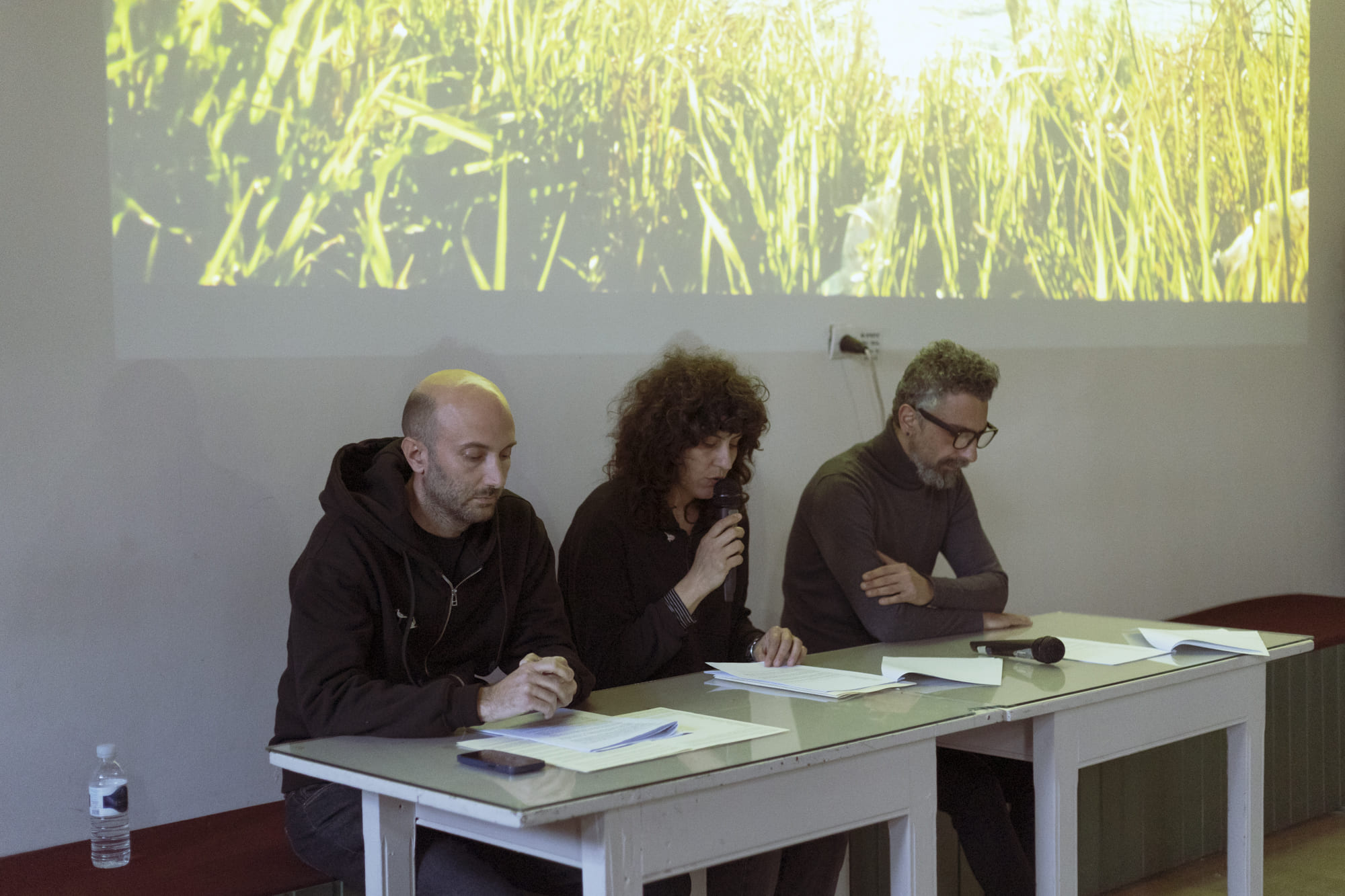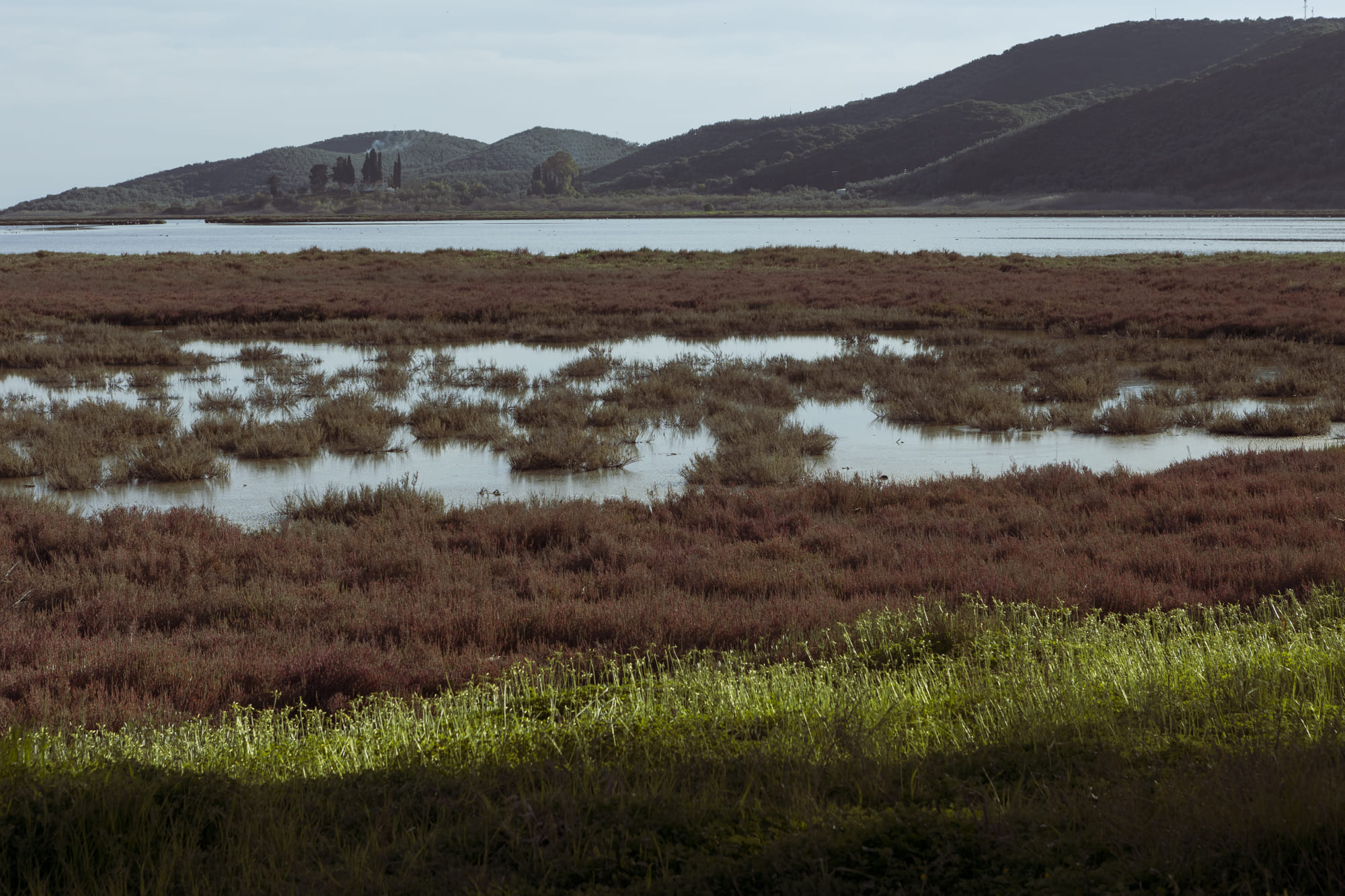vanishing landscapes

Research period:
Public programme dates:
Location:
Contributors:
Curation:
Project Coordinator:
Communications:
Visual identity & graphic design:
Local partners:
Transforming Territories Network partner organisations:
Vanishing Landscapes: A gathering by the waters of Aitoliko
Vanishing Landscapes is a two-year research project culminating in a four-day-on-site gathering at the fragile lagoon of the Aitoliko basin. Its starting point and inspiration is the work of the late artist Vasso Katraki, whose early paintings and prints pay attention to the lagoon and the communities who lived from and worked around it—fishing, surviving, hand to mouth. It is this attention that increasingly sensitised her to the struggles of the working-class, inequalities and civil rights, and that later on enriched her politicised prints with a fervour, manifesting against the Junta and other social injustices. Her early works rooted in Aitoliko offer a prescient reminder of the fundamental role that location, context and interpersonal networks play in forming social consciousness. This series, portraying the living and working conditions, as well as the distinct fishing practices in the lagoon, blends the “social” with “modernist” abstraction through a lens of human experience. It is, however, Katraki’s “social awareness” and her rootedness in land and place that makes Katraki’s practice still relevant today. Amidst the Capitalocene[1] in the age of “hypermobility,” where we can be everywhere and nowhere at once, this gathering hopes to pay tribute to the very same lagoon that Katraki cared for. It will be an opportunity to critically engage with its social, natural, animal complexities and hybridities.
By using the Centre of Engraving Arts – Vasso Katraki Museum in Aitoliko as a springboard, we will explore how an arts institution rooted in land and community can create meaning for the future: from looking back at Katraki’s prints and connecting them to the surrounding environment, to listening to and learning from the human and more-than-human communities that have evolved with the waters, to reflecting on the transforming landscape, so that we can find tools to live together and adapt to our radically changing world.
Vanishing Landscapes is an invitation to experience the fragile ecosystem of Aitoliko, a small island in the Messolonghi basin, often called the “Venice of Greece.” Its overlapping micro-geographies—the Acheloos and Evinos rivers, mingling salt and fresh waters, neighbouring alluvial forests and salt basins—constitute an ecosystem with a vibrant, multilayered biodiversity, making it a key pit stop for migratory birds. The local geography has held sway over the human imagination for centuries, from ancient myths to epic tales and the national fervour surrounding Greece’s independence from Ottoman rule. This dense layering of myths and narratives, which interweave histories, social and political imaginaries and existing topographies, function like a series of overlapping ‘landscapes’, vanishing in the lagoon’s mist only to reappear again, similar to a series of ‘ visual ‘frames’ alternating at a pace too slow for any human eye to discern. In truth, the landscape is neither exclusively wild nor farmed; it has been co-created over generations. The area’s contemporary complexity lies in its apparent ‘naturalness’ and the insidious modernizing terraforming that has taken place over time. Some of the most invasive anthropocentric interventions include the cementing of the island’s canals by the very Junta that Katraki deplored, followed on with constant pushes to transform marshland into arable land, not forgetting the pollution that flows down from up-stream industries into the lagoon. Aitoliko bears the marks of a complex network of forces, human and more-than-human, that shape the land and water.
How can we speak of conservation when we no longer know what to conserve? And how do we factor in the extraneous forces of radical climatic shifts that threaten this delicate balance. Will rising waters irrevocably submerge this fragile landscape, or will drought expose the terraformed land barriers that separate salt and fresh waters? Everything hangs in the balance. Every moment is critical. And yet, as Isabelle Fremeaux and Jay Jordan argue, “development, efficiency, and productivity become the only possible goal of our species. Relationships are captured and commodified. We are split from our food sources, from our soil, from our plants, from our weather and water.”[2] Can we reintroduce ourselves to the many worlds and beings that sustain our lives?
The development of Vanishing Landscapes has been an ongoing collaborative process, shaped by conversations with stakeholders and community members from Aitoliko over the last two years. Through walks, boat and bike rides, listening sessions, shared meals with Michalis, Spyros, Yannis, Marianna and others, we have listened to stories about the native eels that travel from Aitoliko to Bermuda to hatch their eggs, the lonely black swan that haunts the lagoon searching for its mate, and the dwindling number of migratory birds disoriented by a changing climate. These conversations have been filled with joy, a deep sense of indebtedness to the land, but also sorrow and loss. We have witnessed flamingos flying majestically with outstretched wings, as well as abandoned storefronts and deteriorating buildings in the town centre, reflecting a community in flux. As one local remarked, “Aitoliko was developed at the wrong time.” Aitoliko thus stands as a testament to the transient cycle of economic development, the practices and lives left behind, and the places that exist at the margins of the ‘current’ tourist economy.
Vanishing Landscapes, speaks of the cultural, political and economic inequalities of rurality, especially when not supported by an influx of tourists, their respective gaze and matching funds. What does it mean to be invisible in today’s economy, when your time to shine seems to have passed? By returning our attention to Aitoliko, we are reminded not only of shifting geographies but also of alternate time scales—the rise and fall of economies, their structures and ensuing landscapes. As a reminder, nearby at the ancient site of Oiones, the ruins of an ancient shipyard for triremes still stand in a verdant landscape, their waterways gone, replaced by thick reeds and a chorus of chanting frogs: Vrekekexkex.
In some ways, every landscape is a museum of nature.[3] So, what role can a museum situated within a lagoon play in bridging the divide between nature and culture, which have long been artificially separated? The Centre of Engraving Arts – Vasso Katraki Museum, built on a raised hill overlooking the lake, may seem an awkward place to pose this question, with its imposing presence starkly contrasting the delicate prints of Katraki herself. Yet, as the museum, essentially abandoned in the state’s peripheral vision, becomes porous to the outside world and its creatures, it has also become a transient home for visitors: birds frequently perch in its alcoves, it would seem as if they are contributing a score to the overall experience of Katraki’s works. Would Katraki herself perhaps have welcomed these visitors and friendly creatures? The openness of land and place allows us to reconsider the potential of arts institutions and how they can remain relevant to future communities. Is a museum destined to be just a repository of the past or can it evolve into an open space for all beings, human and more-than-human? Could it be a site for creating brave new meanings, a place to rethink our social contract? Or perhaps a site to contemplate our positioning within an ongoing cycle of change—all these ebbs and flows, vanishings and reimaginings that we have talked about..
Could we imagine a museum like this, open, responsive and relevant to our world (and when we say world, we mean our many complex overlapping worlds) – in constant flux?
[1] The term “Capitalocene” was first coined in 2009 by the Swedish human ecologist Andreas Malm, then a doctoral student at the University of Lund. Frequently misunderstood as an alternative geological periodization to the Anthropocene, the Capitalocene’s leading proponents argue for the centrality of capitalism in the making of the climate crisis.
[2] Isabelle Fremeaux and Jay Jordan, We Are ‘Nature’ Defending Itself, Entangling Art, Activism and Autonomous Zones (Pluto Press, 2020), p. 41.
[3] Tristan Garcia, writing on Pierre Huyghe, “Every landscape becomes a museum of nature; from the outset, nature has been infused with every artifice of every species,” in Pierre Huyghe: Liminal (Pinault Collection, 2020), p. 40.
PROGRAMME
Thursday, 6 March 2025
09:00 – 20:00 | Museum exhibition open
Location: Centre of Engraving Arts – Vasso Katraki Museum
09:00 – 20:00 | Skylarking (Long Play), Sound installation by Nuno da Luz
The spatial installation is designed by hiboux ARCHITECTURE using found materials from Aitoliko and carpets from the Women’s Association of Aitoliko
Location: Foyer of the Centre of Engraving Arts – Vasso Katraki Museum
10:00 – 19:00 | People descended from Trees and Deer, Workshop Day One
Yiannis Papadopoulos Engraving Workshop with Fine and Applied Arts students from the University of Western Macedonia (Florina) in Greek
Location: Workshop area, Centre of Engraving Arts – Vasso Katraki Museum
20:00 – 22:00 |Cine-tides: Of wandering islands, misty lagoons, salt marshes and the solitude of the Earth defenders, Film Screening with Cinema Fulgor in Greek and English
Films:
Bloom, Helena Girón & Samuel Delgado (Spain, 2023), digital, 18 min, Spanish with English and Greek subtitles
La Laguna del Soldado (The Soldier’s Lagoon), Pablo Alvarez Mesa (Canada, Colombia, 2024), digital, 75 min, Spanish with English and Greek subtitles
Location: Tavern Charamada (Address: Kourkoumeli and Ethnikis Antistaseos street)
Friday, 7 March 2025
09:00 – 20:00 | Museum exhibition open
Location: Centre of Engraving Arts – Vasso Katraki Museum
09:00 – 20:00 | Skylarking (Long Play), Sound installation by Nuno da Luz
The spatial installation is designed by hiboux ARCHITECTURE using found materials from Aitoliko and carpets from the Women’s Association of Aitoliko
Location: Foyer of the Centre of Engraving Arts – Vasso Katraki Museum
09:00 – 17:00 | People descended from Trees and Deer, Workshop Day Two
Yiannis Papadopoulos Engraving Workshop with Fine and Applied Arts students from the University of Western Macedonia (Florina) in Greek
Location: Workshop area, Centre of Engraving Arts – Vasso Katraki Museum
18:00 – 19:30 | Roundtable: On Vanishing Landscapes, Discussion with Maria-Thalia Carras (TAVROS Director), Michalis Kotsaris (President of Cultural & Educational Association “To Aitoliko”), Yiannis Papadopoulos (artist), Dimitris Theodoropoulos (architect), Foteini Xesfigki (Women’s Association of Aitoliko). Moderation: Thodoris Chondrogiannos (journalist) in Greek
Meeting point: Main entrance of the 1st Primary School of Aitoliko
20:00 – 22:00 | Cine-tides: Of wandering islands, misty lagoons, salt marshes and the solitude of the Earth defenders, Film Screening with Cinema Fulgor in English
Films:
Fleur de Sel (Sea Salt Flower), Rose Lowder (France, 2010), 16mm without dialogue, 32 min
Jardin du Sel (Salt Garden), Rose Lowder (France, 2011), 16mm without dialogue, 15 min
Quiproquo, Rose Lowder (France, 1992), 16mm without dialogue,13 min
Meeting point: Main entrance of the 1st Primary School of Aitoliko
Note: This film programme starts with a collective walk nearby the school
Saturday, 8 March 2025
09:00 – 20:00 | Museum exhibition open
Location: Centre of Engraving Arts – Vasso Katraki Museum
09:00 – 20:00 | Skylarking (Long Play), Sound installation by Nuno da Luz
The spatial installation is designed by hiboux ARCHITECTURE using found materials from Aitoliko and carpets from the Women’s Association of Aitoliko
Location: Foyer of the Centre of Engraving Arts – Vasso Katraki Museum
09:00 – 10:00 | Skylarking (Short Play), Performance by Nuno da Luz (in collaboration with environmentalist Yannis Roussopoulos)
Location: Aghios Nikolaos Koundouros church. Meeting prior to the performance at 08:30 In front of Hotel Alexandra’s main entrance
Note: Sign-in needed – maximum 20 people. Email us on info@tavros.space to secure your place
11:00 – 18:00 | People descended from Trees and Deer, Workshop Day Three
Yiannis Papadopoulos Engraving Workshop with Fine and Applied Arts students from the University of Western Macedonia (Florina) in Greek
Location: Workshop area, Centre of Engraving Arts – Vasso Katraki Museum
11:00- 12:30 | A Stone’s Gaze, Theater workshop by Dulcinea Compania for 8+ year-old children and their caregivers in Greek
Location: Traditional shipyard (“karnayio”) of Aitoliko
Note: Sign-in needed – maximum 20 people. Email us on info@tavros.space to secure your place
12:00-13:30 | Guided tour of Vasso Katraki’s work by Sotiris Germanos
Location: Centre of Engraving Arts – Vasso Katraki Museum
16:00 – 17:00 | Boat ride with local fishermen in collaboration with the association Free Fishermen of Aitoliko
Meeting point: In front of Hotel Alexandra’s main entrance
Note: Sign-in needed – maximum 50 people. Email us on info@tavros.space to secure your place
18:00-19:00 | A place like you and me: Composing stories for transregional liminality, Screening lecture performance by Campus Novel in Greek (performance script available in English)
Location: Cultural & Educational Association “To Aitoliko” building
20:00-22:00 | 20:00 – 22:00 | Cine-tides: Of wandering islands, misty lagoons, salt marshes and the solitude of the Earth defenders, Film Screening with Cinema Fulgor in English
Films:
Geographies of Solitude, Jacquelyn Mills, (Canada, 2022), digital, 103 min, English with Greek subtitles Von Griechenland (From Greece), Peter Nestler (West Germany, Greece, 1965), digital, 27 min, Greek with English subtitles
Location: Cultural & Educational Association “To Aitoliko” building
Sunday, 9 March 2025
09:00 – 17:00 | Exhibition open
Location: Centre of Engraving Arts – Vasso Katraki Museum
09:00 – 17:00 | Skylarking (Long Play), Sound installation by Nuno da Luz
The spatial installation is designed by hiboux ARCHITECTURE using found materials from Aitoliko and carpets from the Women’s Association of Aitoliko
Location: Foyer of the Centre of Engraving Arts – Vasso Katraki Museum
09:00 – 10:00 | Skylarking (Short Play), Performance by Nuno da Luz (in collaboration with environmentalist Yannis Roussopoulos)
Location: Aghios Nikolaos Koundouros church. Meeting prior to the performance at 08:30 In front of Hotel Alexandra’s main entrance
Note: Sign-in needed – maximum 20 people. Email us on info@tavros.space to secure your place
11:00- 12:30 | A Stone’s Gaze, Theater workshop by Dulcinea Compania for 8+ year-old children and their caregivers in Greek
Location: Traditional shipyard (“karnayio”) of Aitoliko
Note: Sign-in needed – maximum 20 people. Email us on info@tavros.space to secure your place
13:00 – 14:00 | People descended from Trees and Deer, Open Studio Engraving Workshop
Yiannis Papadopoulos together with the participants of the workshop will be sharing with the audience their work-in-progress in Greek
Location: Workshop area, Centre of Engraving Arts – Vasso Katraki Museum
14:00 – 16:00 | Collective lunch in collaboration with Women’s Association of Aitoliko
Location: Outdoor workshop area of the Centre of Engraving Arts – Vasso Katraki Museum
* All venues and locations for the Vanishing Landscapes project have been spatially designed by Hiboux ARCHITECTURE, using found materials from Aitoliko
Programme contributions
As part of the Vanishing Landscapes project, we have invited a diverse group of contributors—Nuno da Luz, Yiannis Papadopoulos, Campus Novel, Cinema Fulgor (Portugal), Dulcinea Compania, and hiboux ARCHITECTURE—to create a series of site-specific contributions that explore the region’s delicate ecosystem and its cultural contexts. These contributions will take various forms, including a sound walk, a three-day workshop for fine arts students, and a film programme that encourages reflection on rural cinema and the ways in which we can come together around film far from urban centres.
Nuno da Luz’s contribution, Skylarking, will take two forms: the Skylarking (Long Play) and Skylarking (Short Play). The Skylarking (Long Play) is a long-form listening station that will run continuously for approximately 72 hours, from Friday to Sunday. It will offer a sound continuum blending environmental and elemental sounds, some in real-time and others adapted to the human hearing range. These sounds will evoke the surrounding environments of the Centre of Engraving Arts – Vasso Katraki Museum, including the human and non-human neighbours, the underwater cycles of the lagoon, and seismic activity in the region. On the other hand, Skylarking (Short Play) invites visitors to participate in birdwatching, with a focus on listening to and mimicking birdcalls using the human voice. This participatory collective improvisation allows for exploration of the common origins of speech and music, and it is open to people of all ages, with no prior musical or ornithological experience required.
Campus Novel, in their screening lecture performance A place like you and me: Composing stories for transregional liminality, will challenge organised order, value judgments, and dominant narratives related to living beings and the environment. Through their experimental approach and their performative storytelling, they will explore the threshold between transformation and sensory potential.
Hiboux ARCHITECTURE’s contribution focuses on the spatial design of the vanishing landscapes. Drawing from the local materials and techniques of the Aitoliko lagoon and settlement, Hiboux will create a design that incorporates found remnants and discarded objects (abject) to be rebuilt and woven into the Centre of Engraving Arts – Vasso Katraki Museum’s spaces. This work will add a new layer to the textures of the museum’s building and the artworks it houses, reimagining the space in the context of the shifting landscapes it represents.
The workshop People descended from Trees and Deer by Yiannis Papadopoulos is a three-day research-based workshop that explores the unique natural characteristics of the Aitoliko area, with a focus on producing materials using printmaking practices at the Centre of Engraving Arts – Vasso Katraki Museum. The workshop is specifically offered to Fine Arts students, providing them with the opportunity to connect the local environment with artistic methodologies.
The Dulcinea Compania theater group has created an experiential theatrical tour for children and their caregivers, titled A Stone’s Gaze. Through stories emerging from the water like wriggling fish, images peeling off the stone to gain voice and movement, and a playful theatrical experience inspired by the Centre of Engraving Arts – Vasso Katraki Museum Collection, participants will join a journey that blends imagination with the local environment.
In addition, we have partnered with local organisations and institutions to offer a range of events that unite local communities and visitors. Nuno da Luz’s contribution has been developed in close collaboration with environmentalist Yannis Rousopoulos, and other activities in Aitoliko organised in collaboration with the Cultural & Educational Association “To Aitoliko,” exploring the impressive wetlands and bird migration patterns in the area during March. A boat ride through the lagoon, in collaboration with the Free Fishermen of Aitoliko, will offer a glimpse into the region’s fishing traditions, while a shared meal at the Centre of Engraving Arts – Vasso Katraki Museum, in partnership with the Aitoliko Folklore Museum and Women’s Association, will bring the activities to a close, offering a celebratory experience that unites local flavors, memories, and reflections.
This multi-format programme invites both local and visiting participants to explore the fragile yet resilient landscape of Aitoliko, through collective experiences that blend art, ecology, and community.
Vanishing Landscapes is part of the Transformative Territories: performing transition through the arts European cooperation programme, which aims to redefine the significance of arts and transformative practices within our societies. From 2024 to 2026, our consortium of six partners will explore the profound impact of artistic practices at a territorial level, spanning Greece, Spain, Portugal, France, and the Czech Republic.
Support:
Co-funded by the Creative Europe Programme of the European Union, as part of the project Transformative Territories. Vanishing Landscapes is supported by the National Bank of Greece, Municipality of Sacred Town Messolonghi, Heinrich-Böll Stiftung Thessaloniki and Institut français de Grèce.
